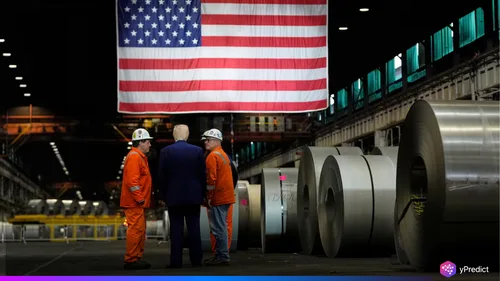
The European Union is preparing to take a major step in trade policy by proposing to eliminate all tariffs on US industrial goods. This proposal is part of the EU’s ongoing process of reducing trade friction with Washington and responding to requests from President Donald Trump. The EU’s aim with tariff liberalization is to obtain a compromise variable in order to strengthen the EU’s economic relationship with the United States, while enhancing market access provisions for industries on both sides of the Atlantic.
The United States is expected to reciprocate by lifting tariffs on automobiles imported from the EU. The automobile sector has always been problematic in the bi-lateral trade discussions. The Trump administration has consistently pointed out the synthetic comparative advantage Europe has in automotive exports over the US automotive market. If the EU gives tariff relief on industrial goods, the hope is that the EU can also strike a reciprocal deal that opens markets to EU car makers while simultaneously avoiding an escalation in a trade dispute that would be detrimental to global markets.
This proposal is not simply an adjustment to the on-going trade environment. It reflects the EU’s drive to preserve fair trade conditions and diminish protectionist tendencies. With bilateral and multilateral trade relationships threatened, the EU’s proposal represents a rationale response to defend open markets, and limits operational impediments to all industries from unnecessary trade restrictions.
Why the EU is Pushing for Tariff Removal
Additionally, the EU’s proposal is important globally. The conversation surrounding tariffs isn’t just about bilateral trade relationships, but equally about how major economies react to overall disruption in trade patterns across the globe. If successful, the EU’s removal of US tariffs on industrial goods could create a model for dialogue with other economies.
For industries, lower tariffs result in reduced cost and increased efficiency and collaboration across borders.For consumers, lower tariffs may mean lower prices on goods, and an accelerated post-pandemic adoption of technological advancement, as they could mean lower prices. In addition, and more significantly, tariff reductions in an agreement may help resolve uncertainties associated with global supply chains that have been strained from multiple factors in recent years including geopolitics and the impacts of the pandemic.
US Expectations: Lowering Auto Trade Tariffs
The automobile market remains central to the negotiations. President Trump has consistently criticized European carmakers for dominating US roads, while American manufacturers face high entry costs in Europe. By connecting EU tariff removal on industrial goods with US reductions in auto trade tariffs, negotiators are trying to create a balanced give-and-take.
This potential shift could reshape the dynamics of car trade. European brands like BMW, Mercedes-Benz, and Volkswagen depend heavily on American consumers. At the same time, US automakers, particularly in the mid-size and electric vehicle categories, want fairer market access in Europe. Lowering auto tariffs could stimulate competition, improve consumer choice, and accelerate innovation in cleaner vehicle technologies.
Broader Impact on Global Trade
The EU’s proposal carries global importance as tariff discussions now involve major economies responding to supply chain disruptions worldwide. If the EU removes tariffs on US industrial goods, it could encourage other nations to open new trade talks.
Tariff cuts lower industry costs, improve efficiency, and strengthen cross-border collaboration. Consumers benefit from competitive pricing and quicker access to new technology. Reduced tariffs also ease uncertainties in global supply chains strained by geopolitics and pandemic-driven shocks.
The Challenges Ahead in Negotiations
Despite the promising outlook, negotiations will not be simple. Both sides must address sensitive political considerations. For the EU, offering tariff relief risks criticism from domestic industries that may feel exposed to US competition. For Washington, reducing auto trade tariffs could draw pushback from groups seeking to protect American jobs.
Moreover, the wider political context may influence negotiations. As elections have introduced respective priorities in Europe and the US, trade policy may be traded off in relation to wider discussions over economic nationalism and global leadership. Careful management of the negotiations would be needed to achieve a balanced result no one side walked away feeling worse off.
Final Thoughts
The EU’s tariff elimination on US industrial goods suggests strong willingness to re-set transatlantic trade. Since each agreed to reduce auto trade tariffs from Washington as part of this package, there is an opportunity to leverage progress and rich develop relationships to settle dealership differences, without too many false hopes of growth. If the arrangement plays out well, then the agreement will perhaps provide relationship comfort, new sources of industrial competitiveness, and increased consumer benefits for years to come across the Biscayne.
Nevertheless, the world is watching. This will stand as an example of how the world’s leading economies will account for trade friction in an era of rentier uncertainty. Through the talks, all companies, politician or muscle memory consumers will hopefully benefit and to also set the framework for global trade relations.






